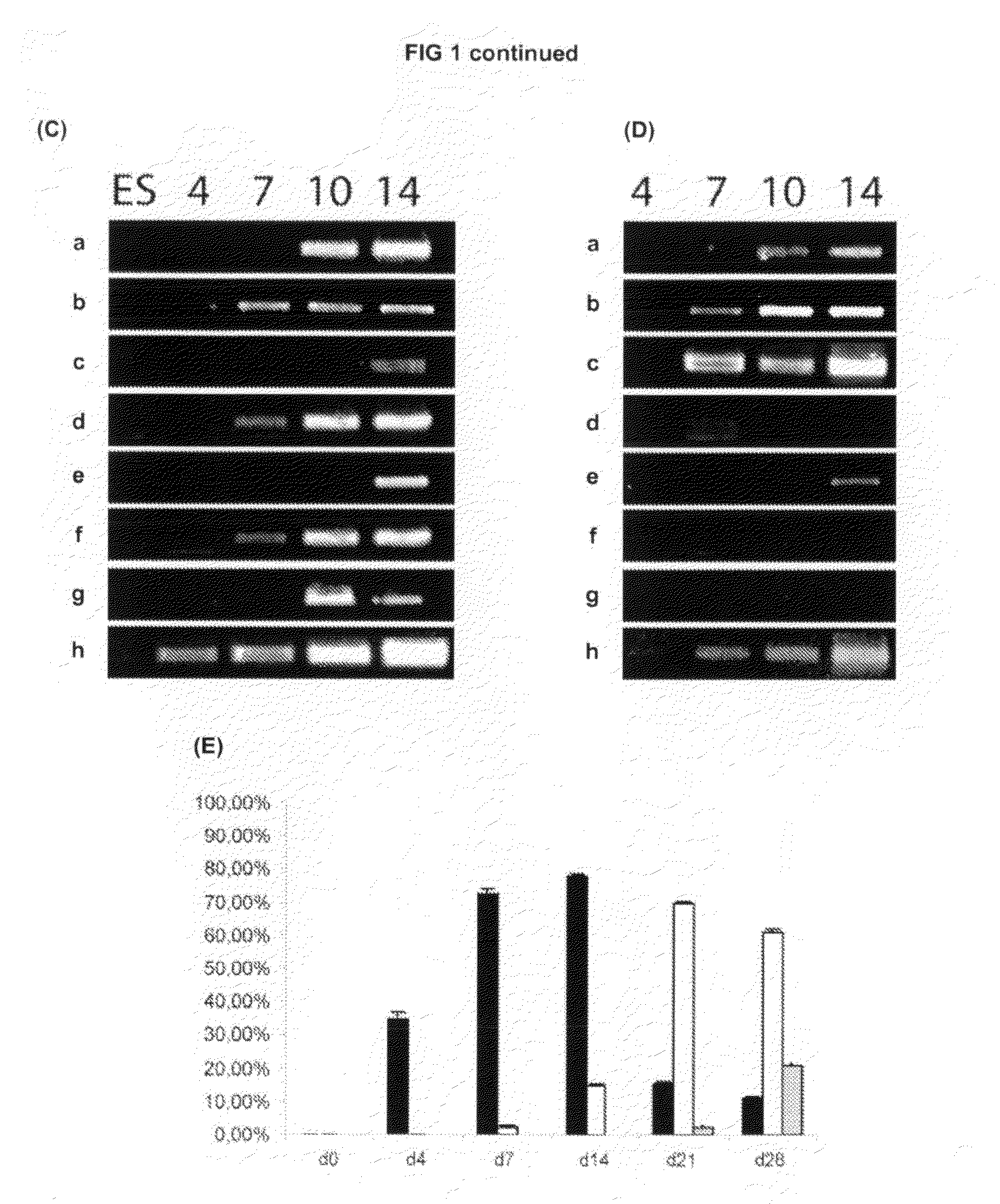Generation of neuronal cells from pluripotent stem cells
a technology of stem cells and neuronal cells, applied in the direction of embryonic cells, biocides, drug compositions, etc., can solve the problems of not being able to disclose any conditions, not having a robust and simple method available to derive cortical neurons readily and consistently from mature or embryonic brain tissue,
- Summary
- Abstract
- Description
- Claims
- Application Information
AI Technical Summary
Benefits of technology
Problems solved by technology
Method used
Image
Examples
example 1
Neurogenesis from ES Cells Following a Default Pathway Generates Forebrain-Like Progenitors
Experimental Procedures
[0148]Unless otherwise specified, all chemicals were obtained from Sigma-Aldrich (Bornem, Belgium).
ES Cell Culture
[0149]Embryonic stem cells (E14Tg2a, obtained from Baygenomics, and E14Tg2a-GFP, a derivative thereof) were routinely propagated in GMEM (Invitrogen-Gibco) supplemented with 10% ES-certified fetal bovine serum (Invitrogen-Gibco), 1×MEM-nonessential amino acids (Invitrogen-Gibco), 2 mM glutamine (Invitrogen-Gibco), 1 mM sodium pyruvate (Invitrogen-Gibco), 55 μM beta-mercaptoethanol (Sigma) and 103 U / ml leukemia inhibitory factor (LIF) (ESGRO) on gelatin-coated cell culture plastic dishes (0.1% gelatin; Sigma) or on mitotically-inactivated mouse embryonic fibroblasts (MEFs: Tau-GFP KI cell line).
[0150]Similar results were obtained with several ES cell lines, including distinct derivatives of E14 and J1 cells. ES cells were trypsinised, dis...
example 2
Antagonizing the SHH Pathway During Default Neurogenesis Converts Most Neural Progenitors to a Cortical Identity
Experimental Procedures
[0162]Experimental procedures were as described in Example 1. When foreseen during neural differentiation, cyclopamine (Calbiochem; dissolved in 100% ethanol) was added from day 2 to day 10 in the differentiation medium (DDM) at a final concentration of 1 μM. Ethanol was used as control.
Results
[0163]We hypothesised that the presence of a large proportion of neural progenitors expressing markers of the ventral forebrain in DDM cultures might be due to SHH activity. Consistent with this hypothesis we found that Shh is induced after two days of DDM culture (FIG. 1C(h)).
[0164]To test whether SHH signalling was indeed active in the system we attempted to block it during differentiation by using cyclopamine, a specific antagonist of the SHH pathway that binds to Smoothened receptor (Chen et al. 2002. Genes Dev 16: 2743-2748), during the neural induction an...
example 3
Neurons Generated from ES Cells in DDM+Cyclo Display Molecular, Cellular, and Functional Properties Characterising Cortical Pyramidal Neurons
Experimental Procedures
[0168]Experimental procedures were as described in Examples 1 and 2.
[0169]Electrophysiological recordings were performed at room temperature (20-25° C.) in an external solution (ACSF) containing 120 mM NaCl, 26 mM NaHCO3, 11 mM D-glucose, 2 mM KCl, 2 mM CaCl2, 1.2 mM MgSO4 and 1.2 mM KH2PO4 with an osmolarity of 290 mOsm. The recording chamber was constantly superfused at a flow rate of 1 ml / min. The recording patch pipettes were made of borosilicate GC100TF-10 capillary tubing (Clark Electrical Instruments, Reading, UK) pulled on a P-2000 micropipette puller (Sutter Instrument Co, Novato, Calif., USA) and presented resistances of 4-6 MΩ when filled with the patch pipette solution containing either 150 mM KCl, 10 mM 4-(2-hydroxyethyl)-1-piperazineethanesulfonic acid (HEPES), 4.6 mM MgCl2, 4 mM Na2ATP (ade...
PUM
| Property | Measurement | Unit |
|---|---|---|
| time | aaaaa | aaaaa |
| angle | aaaaa | aaaaa |
| time | aaaaa | aaaaa |
Abstract
Description
Claims
Application Information
 Login to View More
Login to View More - R&D
- Intellectual Property
- Life Sciences
- Materials
- Tech Scout
- Unparalleled Data Quality
- Higher Quality Content
- 60% Fewer Hallucinations
Browse by: Latest US Patents, China's latest patents, Technical Efficacy Thesaurus, Application Domain, Technology Topic, Popular Technical Reports.
© 2025 PatSnap. All rights reserved.Legal|Privacy policy|Modern Slavery Act Transparency Statement|Sitemap|About US| Contact US: help@patsnap.com



